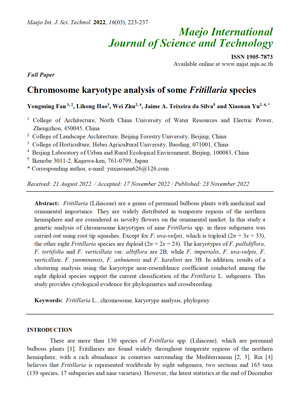NEWS 2022
Chromosome karyotype analysis of some Fritillaria species
Yongming FAN 1, 2, Lihong HAO3, Wei ZHU2, 4,, Jaime A TEIXEIRA da SILVA5, Xiaonan YU2, 4,
Maejo International Journal of Science and Technology 16(03), 223-237 (2022)
http://www.mijst.mju.ac.th/
1, College of Architecture, North China University of Water Resources and Electric Power, Zhengzhou, 450045, China
2, College of Landscape Architecture, Beijing Forestry University, Beijing, China
3, College of Horticulture, Hebei Agricultural University, Baoding, 071001, China
4, Beijing Laboratory of Urban and Rural Ecological Environment, Beijing, 100083, China
5, Ikenobe 3011-2, Kagawa-ken, 761-0799, Japan
Abstract
Fritillaria (Liliaceae) are a genus of perennial bulbous plants with medicinal and ornamental importance. They are widely distributed in temperate regions of the northern hemisphere and are considered as novelty flowers on the ornamental market. In this study a genetic analysis of chromosome karyotypes of nine Fritillaria spp. in three subgenera was carried out using root tip squashes. Except for F. uva-vulpis, which is triploid (2n = 3x = 33), the other eight Fritillaria species are diploid (2n = 2x = 24). The karyotypes of F. pallidiflora, F. tortifolia and F. verticillata var. albiflora are 2B, while F. imperialis, F. uva-vulpis, F. verticillate, F. yunminensis, F. anhuiensis and F. karelinii are 3B. In addition, results of a clustering analysis using the karyotype near-resemblance coefficient conducted among the eight diploid species support the current classification of the Fritillaria L. subgenera. This study provides cytological evidence for phylogenetics and crossbreeding.




